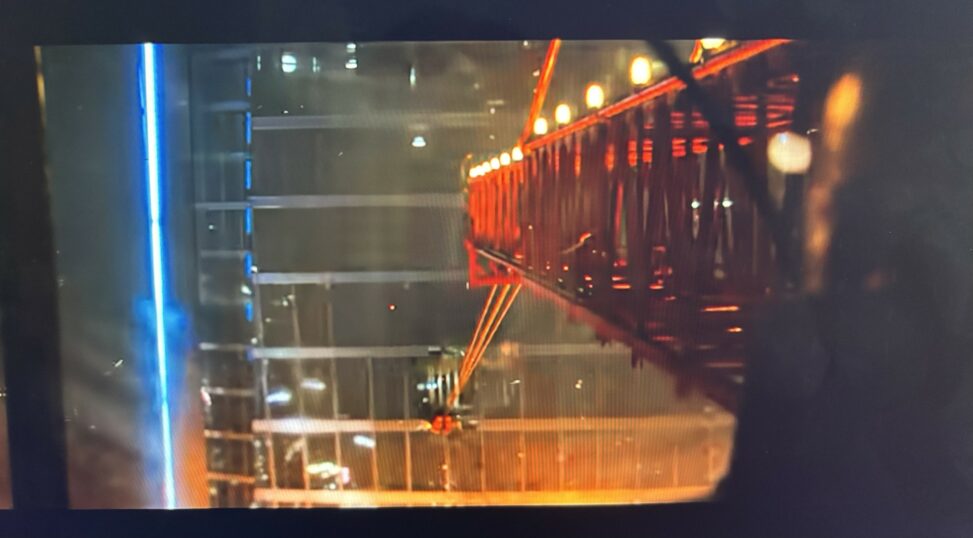The most recent Hollywood action film I have seen is called Skyscraper. I watched this movie on Netflix. However, it is streamed on multiple other platforms as well. This movie was released in 2018 and directed by Rawson Thurber. For some backstory, Will Sawyer (played by Dwayne Johnson) is a former FBI hostage rescue team leader who now works in security assessment. The story takes place in Hong Kong, where Will is hired to inspect a building known as the world’s tallest and most high-tech skyscraper. But then terrorists set fire to the building and frame Will. Will tries to clear his name and fights to save his wife and kids, who are in the burning building. One of the most defining action moments of the film is when the main character, Will, drives a massive crane into a burning building to save his family. The scene is intense and visually dramatic, showcasing a key action trope in Hollywood: a man going to extreme lengths, risking his life in a high-risk rescue mission. The image I captured shows the crane extending towards the building, brightly lit in orange and red, reflecting the urgency and danger of the moment. This scene is a classic example of how Hollywood action films structure scenes with high suspense and heroic determination, keeping viewers on their toes.
The mise en scene emphasizes danger and chaos. The use of lighting in this scene plays a significant role. The red lights along the crane and the glow from the fire inside the building create a strong sense of urgency. The skyscraper looms in the background, standing very tall, emphasizing the scale of its size. This scene also uses vertical space to create tension, as the character is suspended high above ground, emphasizing the risk. Before this scene, we watch Will navigate dangerous obstacles and enemies, and after the crane scene, he leaps onto the crane and then into the building. The violence in this scene is not gory or bloody, but it is still very intense. The environment creates a violent atmosphere: the burning building, broken glass, and high-risk mission.
The main character, Will, is portrayed as physically strong and smart, despite having a prosthetic leg. The action happens fast, but the camera often lingers on Will’s face to help the audience see his fear and determination. The editing includes multiple quick cuts as he drives the crane, climbs onto it and prepares to jump. These cuts increase the speed of the scene, making it feel more intense. There are also slower shots when the camera pulls back to show how high up he is, building suspense. These editing techniques shift the viewer’s point of view, switching between Will’s experience and a more cinematic wide-angle view that reminds us how dangerous the situation is.
The camera movement in this scene is smooth but intense. It follows Will from behind and then cuts to wide shots showing the crane and skyscraper. The seamless camera movement makes the scene feel more natural, but the quick editing also reminds viewers that it is a carefully constructed moment. As a viewer, you become aware of the edits because they are used to create suspense, especially when the camera zooms in on Will’s jump or cuts between him and the fire.
A few scholarly sources I reviewed point out that violence and action in Hollywood movies are often about survival and high-risk situations. Action films use carefully planned visuals to deliver thrills, especially with new digital technology (Prince, 2000). This is seen in the film with the massive CGI skyscraper and dangerous stunts. Also, action films often show masculinity through strength, risk-taking and saving others (Tasker, 2012). The main character, Will, fits this perfectly; he is a family man and a fighter fighting to save his family. Additionally, a study analyzed movie scripts and found that violent characters are often shown as heroes, not just villains, which can blur the lines between right and wrong for viewers (Martinez et al., 2020). In the film, Will is a violent character in the sense that he uses extreme physical action and destruction, like driving a crane into a building, but because his goal is saving his family, the violence is seen as justified.
The film Skyscraper did moderately well at the box office. According to Box Office Mojo, it earned about $304 million worldwide. While not a massive blockbuster like Fast & Furious, it was still successful, especially internationally.
In real life, these kinds of action films can affect how people view danger and heroism. Some may find these scenes exciting, while others may criticize the unrealistic stunts. Another study found that action films often focus more on physical conflict than emotional consequences, making viewers numb to real-world violence (Mcarthur et al., 2000). This connects with the film, where the audience is encouraged to cheer for dangerous stunts without fully thinking about the real-life risk or destruction involved.
In conclusion, this action moment in Skyscraper shows how violence in Hollywood is often about thrilling the audience and showing extreme heroism. The scene uses lighting, sound, camera movement, and editing to build suspense and highlight the character’s strength. Though the violence is not graphic, it still creates tension and danger. As one of the most intense scenes in the movie, it represents the key elements of modern action films: emotion and survival.
References
Box Office Mojo. (2018). https://www.boxofficemojo.com/
Martinez, V. R., Somandepalli, K., Singla, K., Ramanakrishna, A., Uhls, Y. T., & Narayanan, S. (2020). Victim or perpetrator? Analysis of violent characters portrayals from movie scripts. arXiv.org. https://doi.org/10.48550/arXiv.2008.08225
McArthur, D., Peek-Asa, C., Webb, T., Fisher, K., Cook, B., Browne, N., & Kraus, J. (2000). Violence and its injury consequences in American Movies: A public health perspective. Injury Prevention, 6(2), 120–124. https://doi.org/10.1136/ip.6.2.120
Prince, S. (2000). A new pot of gold: Hollywood under the Electronic Rainbow, 1980-1989. Choice Reviews Online, 37(10). https://doi.org/10.5860/choice.37-5585
Tasker, Y. (2012). Spectacular Bodies Gender, Genre and the Action Cinema.


Victoria Warner
I was very impressed by Diya’s attention to detail while analysing the Skyscraper film. Identifying the camera lingering on the face of the main character to emphasize his fear and determination is something only noticed by critical viewers. Additionally, the attention to the cuts and edits of the film and their demonstration of why those are important was well done. Their analysis of the main character was exactly what I expected. With the assignment being about action movies, there is no escaping the ‘strong male lead’ stereotype. However, they made an interesting point using one of the scholarly sources, stating that violent characters are often written as the hero, blurring the lines of right and wrong for the viewer. I think this is important to note as the main character in this film uses violence to attempt to save his family. Despite his motivation being morally understandable, the amount of destruction and death he causes to achieve his goal is profound.
Unfortunately, The photo used does nothing to support all the wonderful information in this paper. We do not see the characters, or any destruction that is mentioned. Using a picture with more supporting properties would’ve elevated this analysis, instead of leaving us wanting more.